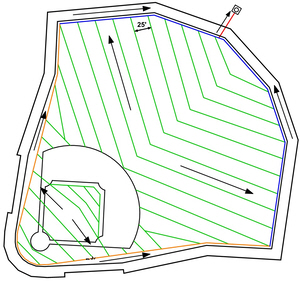Avoid Rainouts With Internal Drainage Systems
/Rainouts = Lost Revenue
It may seem ironic to plan for rain events in Laredo, Texas, but when you consider an organization's lost revenue due to a rainout, an internal drainage system is an investment to significantly reduce the likelihood of such a situation. A venue like Uni-Trade Stadium counts not only on the sales of per-game and season ticket revenue, but the various ballpark vendors - including food, beverage, memorabilia, parking, etc - count on maximizing their time with customers during each game, as well. In short, avoiding rainouts means maximizing ballpark revenues for all baseball games.
Internal Drain System
In the subgrade beneath the grass playing surface at Uni-Trade Stadium lies more than 6,000 linear feet of drainage pipe. The primary drainage product used on this project was Multi-Flow. The drain material was installed vertically in trenches all over the field at precise slopes, carrying the water downhill as it evacuates the root zone and into the collection pipes surrounding the field and eventually "daylighting" into the field's water collection area or storm drain system, far below and away from the field's playing surface.
Moving Water Off The Field
Uni-Trade Stadium's root zone (consisting of 95% sand and 5% peat) that sits atop the internal drain system is capable of percolating in excess of 8" of water each hour. The infield skinned area (and warning track areas), because they consist of materials with higher clay content, will percolate water at a much slower rate than the baseball field's grass areas. This is where a well designed and professionally constructed infield becomes so important. In a rain event (in situations where no tarp is covering the infield), the water will surface drain (or "sheet drain") according to the precise slopes engineered into the infield, moving from the skinned area to the grass where the high performance sand root zone will allow the water to quickly evacuate the playing surface and enter into the internal drainage system. Usually a tarp is covering the infield skinned area during moderate to heavy rains. After the rain, the tarp will be rolled off the infield, pushing large amounts of water into the outfield at once.
With the sand root zone and internal drainage system, the excess water quickly evacuates from the playing field surface and into the collection pipes, allowing for athletic field activities to resume much sooner knowing the field is not overly saturated and is ready for baseball. Without a sandy root zone and drainage system, this water would remain on the field surface much longer and very slowly percolate down through the soil, causing an unsafe and unplayable field for many hours (even days in the worst of cases).
Photo Gallery - TMC @ Uni-Trade Stadium
Visit the photo gallery to see more Uni-Trade Stadium baseball field construction images.
Check out the TMC Facebook page for even more TMC sports field construction photos at Laredo's new ballpark.




